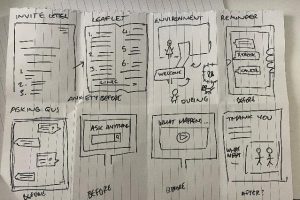
We recently shared our top tips for user research in a crisis, talking through how we adapted to support services involved in Essex County Council’s response to the pandemic. Here's a really candid reflection on what we'd do differently if we had our time again.
Don’t worry about what you can’t change
Because this work was moving so quickly, it was hard to know when to best conduct user research, and how to manage it quickly enough so that its findings could be actioned in a timely way. We had a few ways to manage this, but sometimes, we failed.
The biggest example of this was when we enthusiastically tested service design concepts, based on insights from previous rounds. We soon realised that the changes we were proposing would be difficult to deliver.
We would have needed to work intensively and quickly with partners across the system for these changes to work. This simply was not possible given that these partners were currently managing a crisis.

Our enthusiasm outweighed our pragmatism! We should have thought a little longer about what we would need to enable change before exploring design options - you live and learn.
Have faith that your research is worth people’s time
In our last blog post, we noted how we had fed back our research to a range of internal colleagues, including colleagues in communications, strategy, policy, and business design.
But Local Government is a complex system, and we often work with colleagues ‘beyond our walls’ to deliver services. At times, we were so focused on the research ‘doing’, that we didn’t allow enough time to make those all important stakeholder connections. Sometimes we made the excuse that these stakeholders might be too busy to talk to us because of the crisis.
There’s no point doing the research if you’re not reaching all the people who could benefit from it.
Eventually, we put some focused effort into reaching these stakeholders—we worked with project sponsors to establish links and give our work urgency and legitimacy. We shared what we were learning in meetings where we knew a range of relevant representatives would be. But in hindsight, we should have done this earlier, not weeks into the work.
Get creative with how you share insights
Because our stakeholders were so busy, it was hard to get them to observe our research. That’s a problem, because this is one of the main things that makes our insights ‘stick’.
If we had our time again, we would try and further flex our research outputs, to support stakeholders to engage with our insights:
- For stakeholders short on time: we would provide a short update at pre-existing meetings (less than 5 minutes) and create a short video reel of the user research, to highlight key insights.
- For stakeholders with a little more time: We would arrange targeted meetings to share insights in more detail, supported by video reels, and with time to discuss potential actions.
- For stakeholders with more time: we would have better forward-planning for research rounds, to enable time for stakeholders to observe research sessions themselves (each of our research rounds were arranged and planned within just one week). We would also have involved these stakeholders in analysis following each research round, so that they were fully engaged in the research process.
Leave a comment